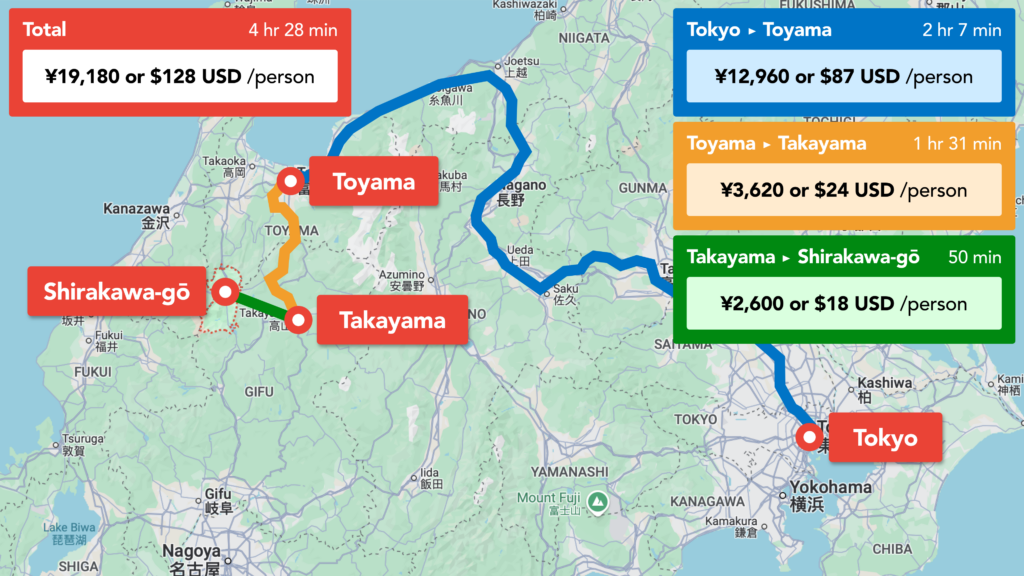Shirakawa-gō
About Shirakawa-gō
Nestled in the mountainous region of Gifu Prefecture, Shirakawa-gō is a UNESCO World Heritage site renowned for its picturesque villages and unique gassho-zukuri farmhouses. The gassho-zukuri farmhouses are thatched-roof homes built to withstand heavy snowfall and are a testament to the ingenuity of traditional Japanese architecture. The area offers a step back in time, showcasing the harmony between nature and human habitation.
Whether you visit in spring for the lush greenery, summer for the vibrant rice fields, autumn for fall vibes, or winter for its snow-covered wonderland, Shirakawa-go promises an unforgettable experience.
In 1995, Shirakawa-gō was designated as a UNESCO World Heritage Site due to its cultural significance and preservation of Japanese rural life. Approximately 1,500 residents live here, continuing their day-to-day lives while preserving the village traditions.
How to Get to Shirakawa-gō
Reaching Shirakawa-gō is straightforward but requires some planning. Here are the primary transportation options:
- By Train: There is no direct train to Shirakawa-gō but you can take the Hokuriku Shinkansen to Kanazawa, Takaoka or Toyama, then take a bus to Shirakawa-gō. You can also transfer via the Hida Limited Express from Toyama to Takayama and then take a shorter bus ride from Takayama.
- By Bus: Direct buses from Takayama, Kanazawa, Takaoka or Toyama take about an hour. Advance bus reservations are recommended, particularly during peak seasons.
- Some buses leave for Shirakawa-gō as early as 7AM!
- By Car: For those driving, the village is accessible via the Tokai-Hokuriku Expressway. Parking is available near the village, but spaces can fill up quickly.
How We Travelled to Shirakawa-gō
The most popular itinerary, like we did, combines Shirakawa-gō with Takayama, a town known for its beautifully preserved Edo-period streets and traditional wooden houses!
- We took the bus from Takayama Nohi Bus Center to Shirakawa-gō (Ogimachi). It was JPY 2,600 for each bus ticket.
- We travelled using the Nohi Bus Company.
Overall, we travelled in a loop from Tokyo → Toyama → Takayama → Shirakawa-gō → Kanazawa → Kyoto. This allowed us to explore multiple cities and regions efficiently!

Five Tips for Visiting Shirakawa-gō
- Plan Ahead: If you’re visiting during the winter illuminations or peak seasons, book your accommodation and transportation well in advance. Limited slots, high demand and the lottery system for the Winter Light-Up Event make planning crucial.
- Stay Overnight: Staying overnight offers a unique experience of the village after the day-trippers leave! It’s highly recommended to book early to secure an accommodation.
- Respect the Residents: Shirakawa-gō is a living village. Be mindful of noise levels, stick to designated paths, and avoid entering private properties without permission.
- Explore Beyond the Main Village: While Ogimachi is the most famous part of Shirakawa-gō, nearby areas like Suganuma and Ainokura offer a quieter experience with the same charm.
- Indulge in Local Delicacies: Hida beef, soba noodles, Goheimochi (grilled rice cakes), and Doburoku sake are some must-try foods in the region. Don’t miss the award-winning pudding at Shirakawa-gō Purin No Ie (House of Pudding).
With its timeless beauty and cultural significance, Shirakawa-gō is more than a travel destination—it’s an experience that immerses you in the essence of Japan’s heritage!
